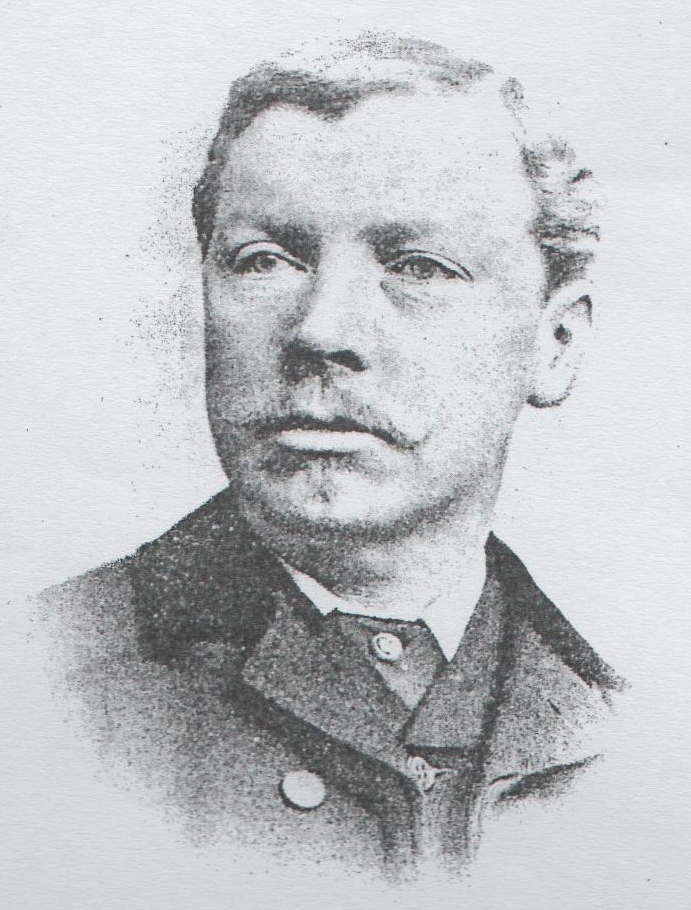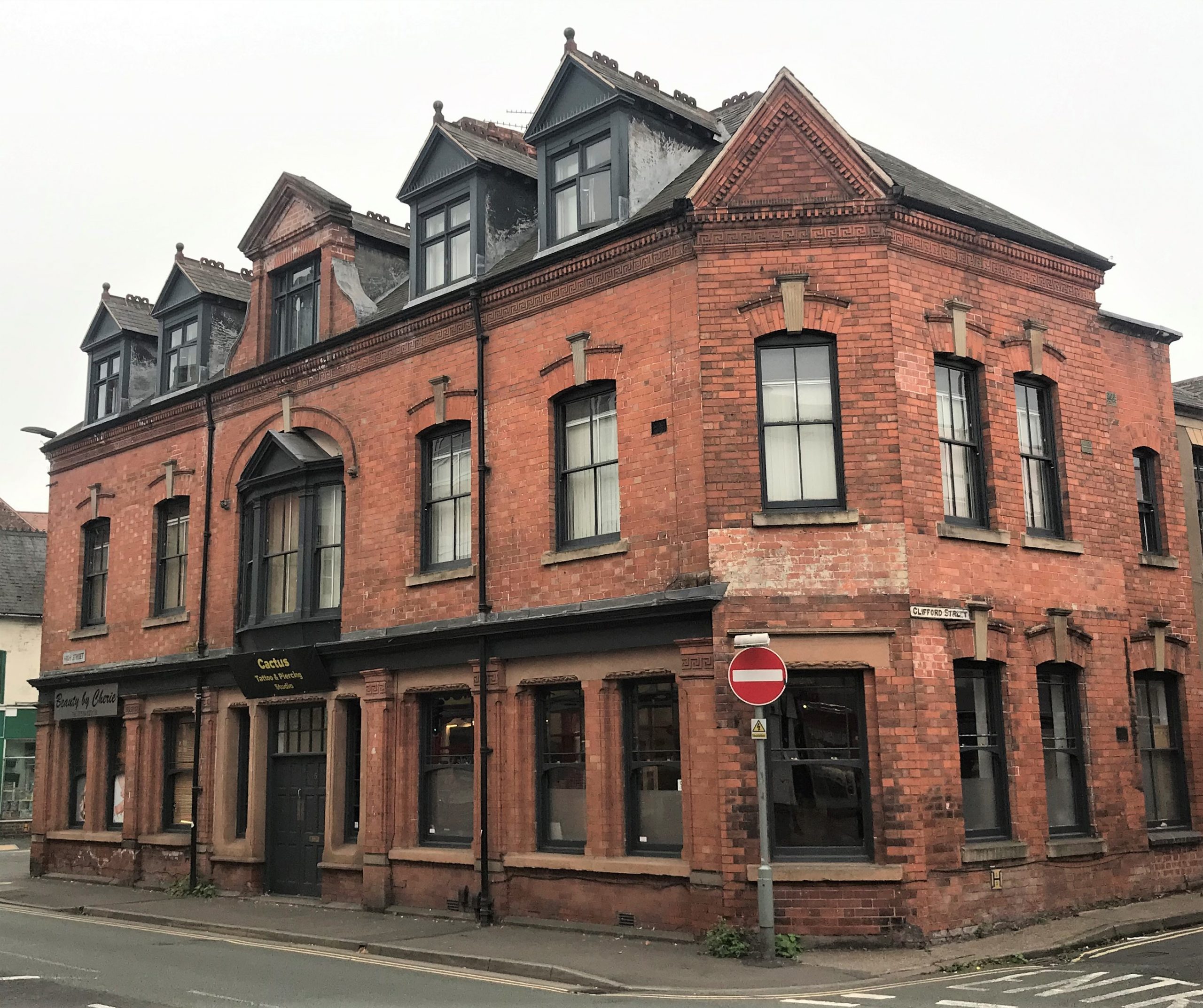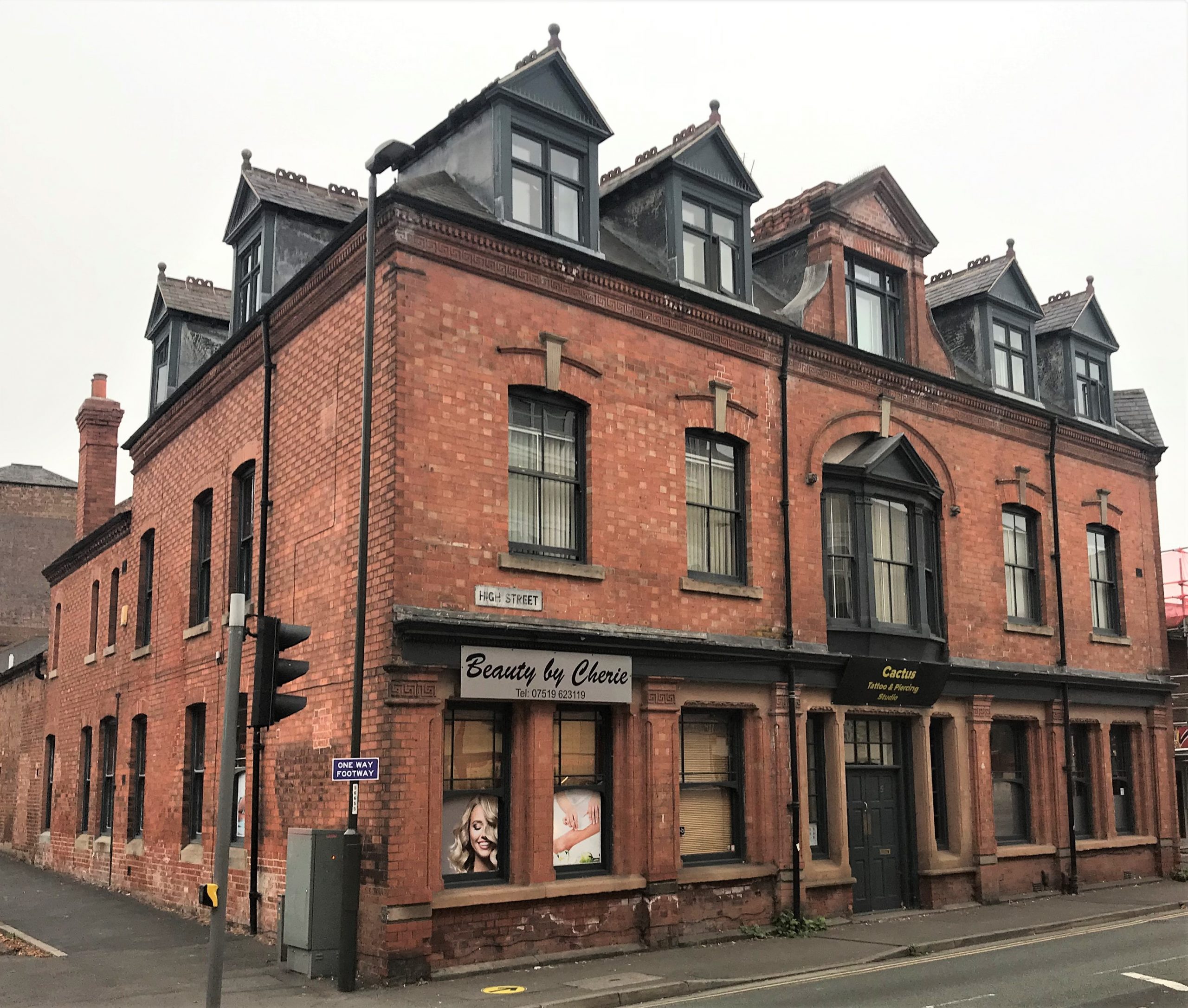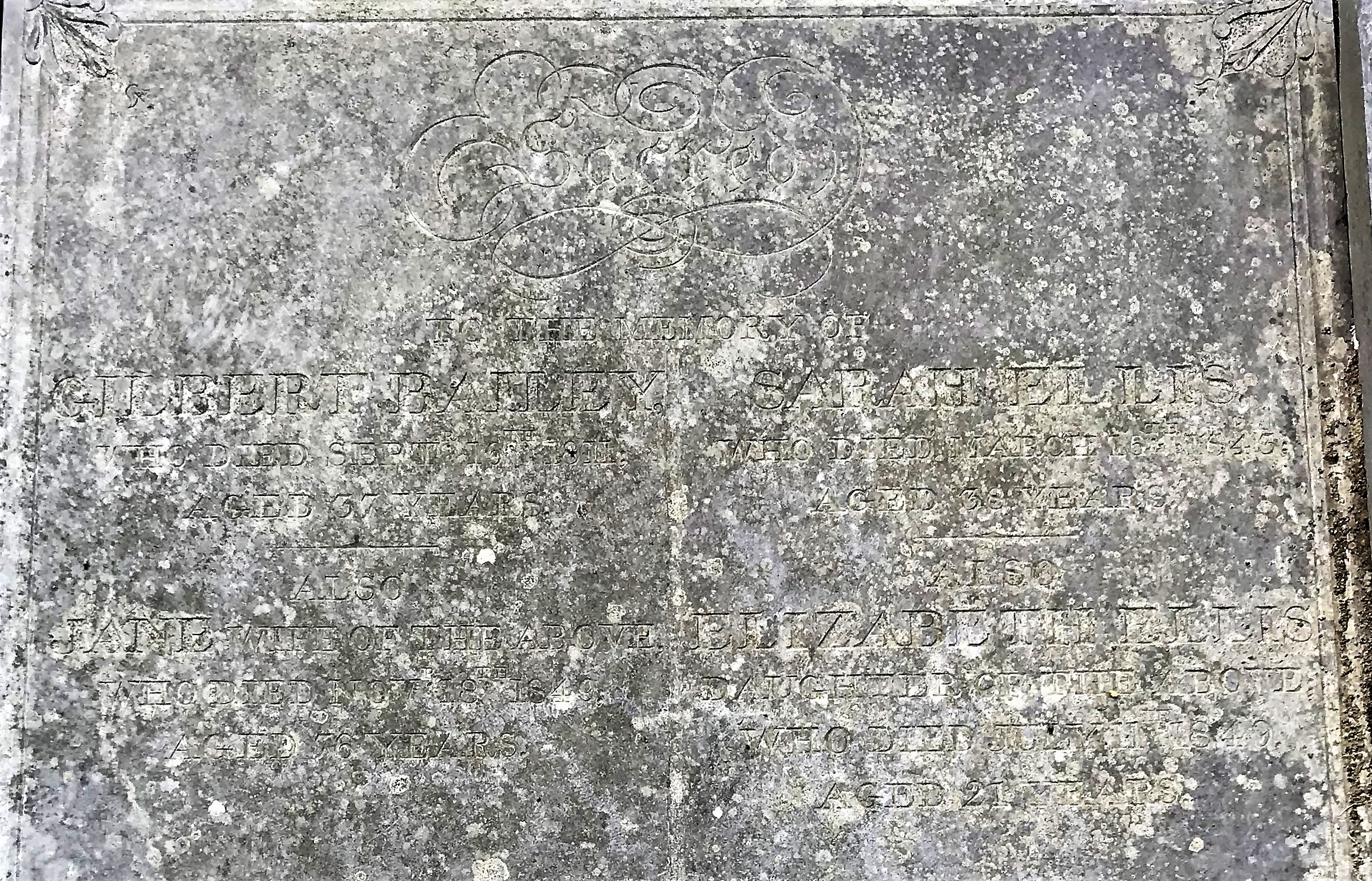From the Horse and Groom Inn we walk back up Nottingham Road towards town.
The Flints.
Adeline takes us on, up Nottingham Road ….. “Returning past the old Gallows Inn, we again cross the bridge, and very soon are at the house standing back from the road, where Mr. and Mrs. Flint, Mrs. Flint, sen., and the two daughters, Lizzie and Lavinia, lived. Mr. Flint was a cattle dealer”.
In 1871 this was 32 Nottingham Road and in 1874 it was called ‘Grove Cottage’.
Newthorpe-born John Flint and wife Ann (nee Beet) came to the Ilkeston area about 1850, shortly after their marriage.
The 1851 census finds John working as Station Master at the railway gate house in Shipley.
Daughter Sarah Elizabeth was born at Shipley in January 1851 and Lavinia in 1853.
By 1861 the family were living at Gallows Inn where John was a cottager.
“Lavinia married Mr. Ted Tatham, second son of Mr. Edmund Tatham. Unfortunately she fell a victim to consumption after her first baby died”.
In May 1874 Lavinia Flint had married Edmund ‘Ted’ Tatham, the third son of needlemaker Edmund and Elizabeth (nee Burgin-Richardson).
The couple had two children, John Percy and Lizzie Ann, both of whom died in infancy, and it was about four months after the birth of the daughter that Lavinia died of consumption ‘after a lingering illness’, aged 23.
Thus Edmund lost his wife less than two weeks after losing his mother.
In October 1878 Edmund married again, to Eliza Ann ‘Lizzie’ Goodacre, daughter of miller and farmer Samuel and Sarah Eliza (nee Parker) of Manor Farm, Trowell, and just over a year later daughter Lizzie Winifred was born.
Edmund Tatham about 1887.
In the early 1890’s the family went to Long Eaton to keep the Royal Hotel there.
Two views of the erstwhile Royal Hotel, nestled between Clifford Street, West Gate and Main Road (September 2021)
About 1893 the family again moved, this time to the New Inn in King Street, Derby and it was there that Edmund died in June 1894.
He was buried at Nottingham Road Cemetery in Derby.
Lizzie (Lavinia’s sister) also died of the same malady. (i.e. Consumption).
Also aged 23, Sarah Elizabeth died unmarried in October 1874, less than three weeks before the death of her father.
Their mother was very frail and died in middle age.
Farmer John Flint died in November 1874, aged 52.
His wife Ann – ‘their mother’ – was also aged 52 when she died in Kensington, in February 1878.
———————————————————————————————————————————————-
The Horsley house.
“Coming up the road we come to a very pleasant looking house on the bank, right away from the road”.
Born about 1790 Ann Dorothy James was the daughter of mercer (textile trader) Samuel and Elizabeth (nee Roe) and had married Henry Sharp Horsley, book-keeper later hosier, in 1810.
After her husband died abroad in 1845, she lived with Eliza, one of her daughters — a dressmaker like her mother — and her brother Thomas Roe James, at one time in East Street and later in Nottingham Road.
The family had income from property and land.
Ann Dorothy died in November 1861, aged 62, and her brother in January 1863, aged 78.
Both were buried in St. Mary’s Churchyard.
“In this house lived a maiden lady, Miss Horsley. In later years the Rev. John Wilson, junior Wesleyan minister, had rooms in the same house”.
Here Adeline is probably remembering the daughter Eliza Horsley who continued to live in Nottingham Road.
The 1871 Census records her, alone, at 1 Hugh Villa, Nottingham Road.
She continued to live in Nottingham Road but died in Union Road in March 1886, aged 74.
—————————————————————————————————————————————-
Too late to save his bacon !!
In 1856 the Ilkeston Pioneer reported a shocking story …
As John Knighton, the carrier, was returning from Nottingham last night, some worthless scoundrel stole from his cart a large piece of bacon, while between Gallow’s Inn and Mr. John Eaton’s on Nottingham Road.
Knighton had stopped at Mr. Revill’s Gallow’s Inn and left a side of bacon there, and then tied the remaining piece, as he thought, very securely to the cratch* of his cart, but to the astonishment of Mrs. Eaton and himself, when they dismounted the bacon was gone !
Search was made for it immediately, but only the paper in which it was wrapt was to be found, and that was picked up on the foot-road near Mr. Hobson’s. Some youths at a bonfire stated that they had seen a man walking behind the cart, who, doubtless, would be the thief.
John William Knighton the carrier set out from Granby Street for Nottingham every Wednesday and Saturday (and to Derby every Friday). It looks like he had delivered provisions to ‘Mr. Revill‘ at Gallows Inn on his return journey … this was Samuel Revill who traded as a grocer, close by the Horse and Groom Inn. What was left of the bacon was secured inside the cratch or trough, by the seat of his cart … and off he set for John Eaton who lived near to the White Cow beerhouse at Hunger Hill. And somewhere along the journey the bacon ‘escaped’. Mr Matthew Hobson lived at Field House, at the back of the White Cow, and so the foot-road would be a path in that area.
—————————————————————————————————————————————-
Albany Street in 1897
By 1897 this road had been laid out and, although dedicated to the public and used as a public highway, it was a dead-end and hadn’t yet been taken over by the Town Council.
It was however the home of coalminer Robert Frederick Ratcliffe, his wife Emily (nee Cooper) and several children. On June 10th, 1897 his daughter Florence Eris, just over two years old, fell against a barbed wire fence around the field of builder and contractor John Harper which adjoined Albany Street. The sight in one of her eyes was almost totally destroyed. Therefore at Ilkeston County Court Robert sued the builder for the injuries suffered by his daughter.
Several people testified that the fence was dangerous and a nuisance to the public, although the magistrate accepted that John had repaired and maintained it. It had been suggested that it was on someone else’s land but John certainly used it as the fence to his field … and it was definately his field !! The legal point of contributory negligance had to be considered (i.e. young Florence was unaccompanied by either of her parents — so were they or she responsible for carelessly causing her injuries ?) but it was felt that she was entitled to be on the road alone and feel safe there, especially as it wasn’t a thoroughfare.
The Barbed Wire Act of 1893 laid out that the owner of land adjoining a highway was liable for the cost of the removal of barbed wire by the local authority if it was dangerous. This clause in the Act went to show that John was responsible for any nuisance caused by his fence, even though he may not have erected it in the first place. He used it as a boundary for his land.
The judge therefore ruled in favour of Robert, and as the injury to Florence was so serious he awarded the full amount of £50, claimed by the father — £20 was for his expenses entailed by the accident and the rest to be invested in the Post Office Savings Bank for Florence’s future use.
—————————————————————————————————————————————-
The Roses in Nottingham Road.
“Continuing up the road we come to another old house, gable to the road. When Mr. Rose, the rate collector, gave up the shoe shop in Bath Street, he, his wife, and daughter, Mrs. Phillips, came to live in this house”.
We shall meet William Rose and his family later in Bath Street.
In this area — at Grangewood House — lived the family of Wright Lissett, in the later years of the nineteenth century.
The house was built on the site of Joseph Siddon’s lodging house.
Writing in November 1891, in a letter to the Ilkeston Pioneer, ‘Kensington’ remembered …
Old Joe Siddons ‘Lodgings for travellers’ has disappeared; and this peculiarly designed villa on its site is the residence for the Town Clerk (Wright Lissett).
Joe was certainly still there in 1887, then aged 80 (so he said) and resting in his chair, when one of his lodgers — Margaret Smith — took his silver watch and chain, value £2 10s from out of his pocket and without his permission. The items were both found later under a garden hedge, while Margaret was found later at Derby jail where she spent the next two months. (She had pleaded guilty).
—————————————————————————————————————————————————–
The Richards family.
“There were no more buildings until we come to the old cottage opposite Regent Street. Here lived Mr. and Mrs. Richards and their two children”.
There is a Richards family matching this description at 17 Nottingham Road on the 1871 census.
“The girl became a dressmaker, the boy I am afraid I have forgotten”.
The Richards family was perhaps that of Nuthall-born labourer/gardener George, the illegitimate son of Elizabeth, and his wife Mary (nee Henson), daughter of labourer George and Fanny (nee Gadsby).
Coming from the Nuthall area to live in Nottingham Road the family appears on the 1871 census showing daughter Thirza, aged 22, as a dressmaker while ‘forgotten’ son Arthur, aged 12, is a scholar. (Eldest son Henry George had already left home to marry Dinah Owen in 1869)
The Richards left Nottingham Road to farm in Sandiacre/Dale Abbey area where father George was reunited with son Henry George.
—————————————————————————————————————————————
The last house.
Adeline seems to have a hazy memory of the residents at the top of Nottingham Road; — “The last building on the east side of Nottingham Road was an old farm house. I remember going there for butter and eggs. I believe the name of the people was Gilbert”.
This old farm house on Nottingham Road was perhaps the property of Stapleford-born farmer Gilbert Bailey junior, son of lacemaker Gilbert senior and Jane (nee Thompson)…. at 8 Nottingham Road in 1871. Gilbert junior married Mary Ann Allen, daughter of John Allen, the sexton of St. Nicholas’ Church in Nottingham, and Elizabeth (nee Tong). The Bailey family held property in this part of Nottingham Road and into Park Road, comprising several dwelling houses — copyhold and freehold — outbuildings, an orchard, gardens and pasture land.
Their only child was John Allen Bailey who always “seemed to be in a chronic state of ‘elevation’, and whose weekly delight it was to sit on a wall in White Lion Square banging vigorously on a tin can in derisive accompaniment to the Salvation Army Band which performed in the Square on Sunday mornings”. (RBH)
Gilbert junior died in Nottingham Road on August 10th, 1874, aged 71.
Son John Allen died in Nottingham Road on October 27th, 1883, aged 36.
A few months after the death of her son — in March 1884 — Mary Ann Gilbert tried unsuccessfully to auction off the ‘estate’ which was described as fronting Park Road and Nottingham Road. Mary Ann died also in Nottingham Road on February 1st, 1887, aged 78.
Below is the gravestone of Gilbert Bailey senior and several others of the family. It is lying in the south section of St. Mary’s graveyard. There is quite a large lower part of the slate left ‘blank’ — perhaps destined for later inclusions but not used ??
On the left …. Sacred to the memory of Gilbert Bailey who died Septr 16th 1811, aged 37 years.
Also Jane wife of the above who died Novr 18th 1849, aged 79.
On the right …. Sarah Ellis who died March 16th 1843, aged 38 years
Also Elizabeth Ellis, daughter of the above who died July 11th 1849, aged 21 years.
Sarah Ellis (nee Bailey) was Gilbert junior’s sister who married lacemaker Elijah Ellis on August 8th, 1826; (Jane) Elizabeth was their oldest daughter, born on July 4th 1828.
Gilbert’s younger brother John, a plumber and glazier, had married Mary Ann’s younger sister Sarah Stella Allen on January 24th, 1839 … also at her father’s Nottingham church.
When John died, Sarah Stella lived for a time with her sister and brother-in-law at their Nottingham Road farm.
—————————————————————————————————————————————————-
And this brings us into White Lion Square and the streets leading off from it.
Below the site of the present St John’s Church in Nottingham Road there were no more than about 20 houses before reaching the Erewash.





